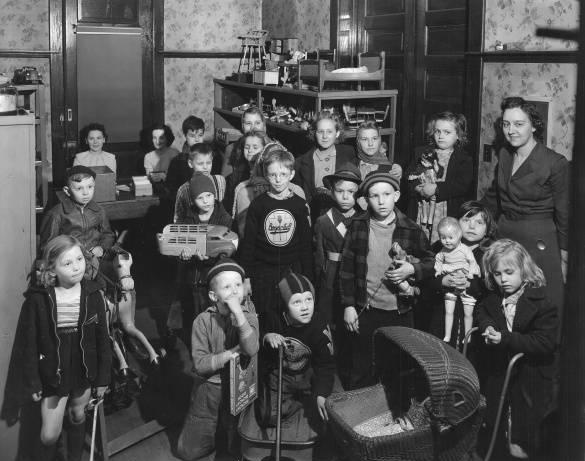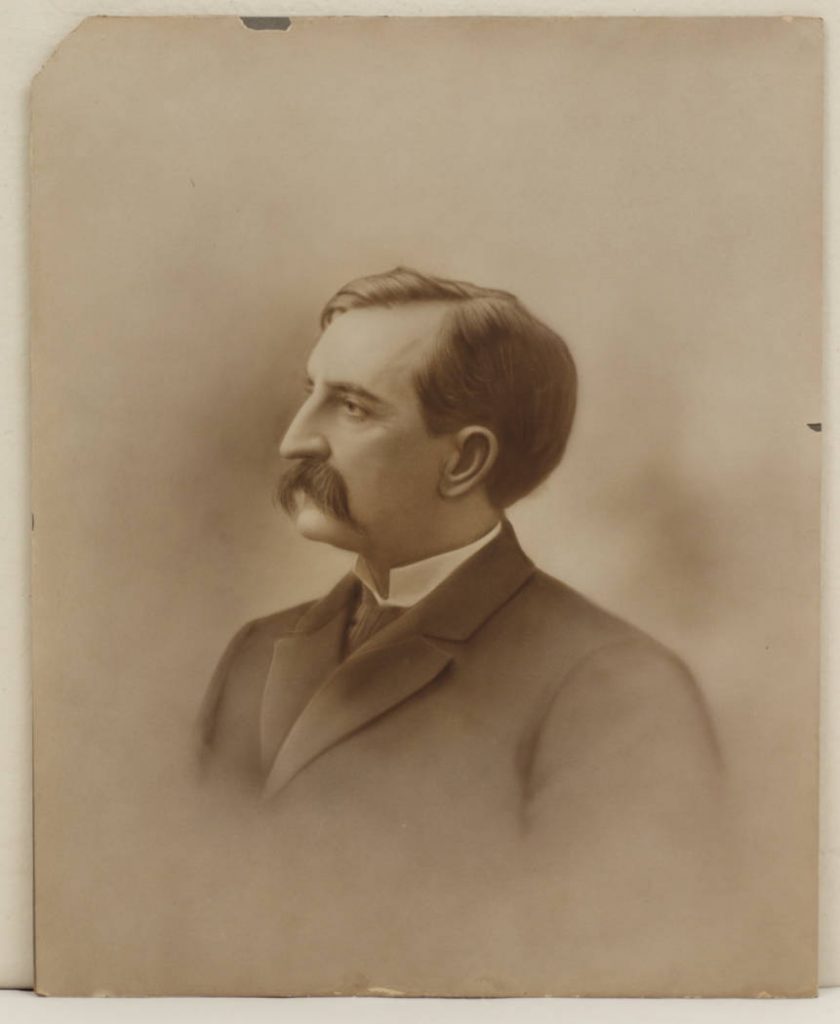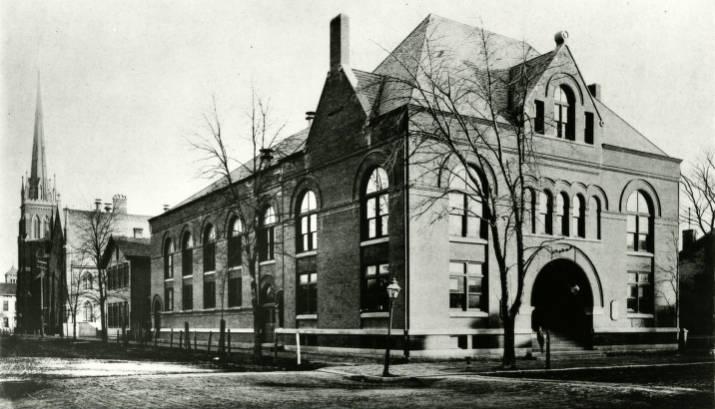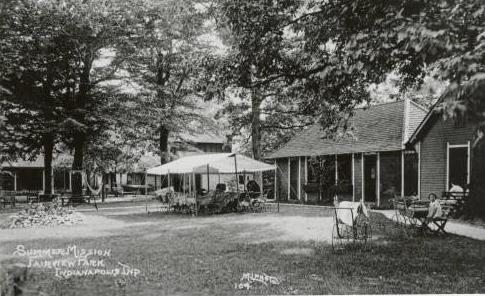Families First, a nonprofit social service agency that serves to prevent child abuse, preserve families, and provide recovery services, finds its roots in the early history of Indianapolis. Beginning as the Indianapolis Benevolent Society, that history follows changing attitudes toward the provision of aid to families and children throughout time.
Indianapolis Benevolent Society, 1835-1879

On Thanksgiving Day, 1835, businessmen James Blake and , attorney , and other early city civic leaders formed the Indianapolis Benevolent Society (IBS) “to relieve the necessities of the poor of the city of Indianapolis … by means of voluntary contributions.” It was only the fourth private poor-relief agency in the country and the first in the United States organized to meet the needs of individuals and families on a community-wide basis without regard to race or creed.
The organizers personally had supplied food, clothing, and sometimes money to supplement Marion County’s limited allocation of public funds for poor relief, but they sought a more systematic method of collecting donations and aiding neighbors. The society’s mission also encompassed broader notions of community, to help individuals and families with personal problems, and “to strengthen family life.” The IBS was an entirely volunteer organization until 1879.
Charity Organization Society, 1879-1921
The Indianapolis Benevolent Society (IBS) talked of disbanding after the economic depression of the 1870s. IBS leader Reverend pastor of , invited Reverend Gurteen of Buffalo’s Charity Organization Society to speak at the IBS 1879 annual meeting. Gurteen’s presentation compelled civic leaders to create the Charity Organization Society (COS).

In 1879, in the law offices of future U.S. president , the IBS established the Charity Organization Society (COS) and hired its first staff member. Its office in Plymouth Church on monument circle operated 24 hours a day and linked to the city using new technology for the time, the telephone.
The Charity Organization Society screened prospective clients and the Indianapolis Benevolent Society provided aid. Although they maintained separate identities, they functioned as two branches of the same organization and shared an executive and board of directors.
The COS provided relief to the deserving poor, reduced the causes of permanent dependency, and substituted work for relief. It investigated requests for assistance, maintained a confidential exchange of information for cooperating agencies, requested aid from appropriate agencies, and kept case records. To encourage thrift, it set up the Dime Savings and Loan Association, assigned volunteers to families to give advice about being thrifty and industrious, sponsored public lectures on the causes and cures of chronic poverty, and set up committees on the reduction of crime, municipal cooperation, penal and charitable institutions, and the cultivation of community gardens. The COS’s commitment to substituting work for relief led in 1880 to the Friendly Inn and Wood-Yard to provide work and lodging for transients.
During the summer of 1889, one of John and ‘s children fell ill. The heat aggravated the illness, prompting , founder of the , to write an editorial about the needs of poor children during the summer months. As a result, the Summer Mission for Sick Children opened under the auspices of the COS and in the style of “fresh air missions” conceived by the New York Children’s Aid Society.

The Summer Mission offered fresh air and free medical care in a pastoral setting several miles from the city at , site of today’s . With a district nurse’s or doctor’s order, mothers and children received complimentary rail transportation to and from the mission, daily rest and meals, and nursing supervision. The formed the Fresh Air Fund and recruited children to raise money.
The COS and its related women’s organization, the Mothers’ Aid Society, also experimented with a “widows’ colony” for women and children without fathers. The organization again used Fairview Park where unemployed men built cottages that were offered rent-free to widows with children. It became known as Fairview Settlement because of its location. During the 1907-1908 depression, the COS partnered with the city to create public works jobs for other unemployed workers.

By 1910, Fairview Settlement included seven cottages, a central kitchen, grocery, laundry, Sunday school, and a day nursery. The COS promoted the Summer Mission and Fairview Settlement as national models, noting that “experts from New York and other cities have visited it and commended it highly.” The widows’ colony model fell out of favor and closed in 1920.
By the 1910s, competing child welfare programs made fundraising increasingly difficult. The Summer Mission, Cheeryvale (another summer camp located near ), the Children’s Aid Association, and Relief for Children consolidated their work in 1918. The Summer Mission kept its property and endowment funds and operated as part of The Children’s Aid Association. The camp closed in 1924 and sold the land to Butler University.
Family Welfare Society, 1922-1944
The Charity Organization Society, Indianapolis Benevolent Society, Children’s Aid Association, and Mother’s Aid Society merged in 1922 into a new organization, the Family Welfare Society (FWS), to address family problems. FWS functioned through two divisions: the Service and Relief Division, which had responsibility for family relief and rehabilitation, and the Children’s Bureau, which cared for children outside their own homes.
In 1934 the Children’s Bureau was transferred to what became . Following the establishment of government relief programs during the Great Depression, the Family Welfare Society decreased its direct relief activities and focused on family casework. FWS assisted family members who could benefit most from counseling services: a widow adjusting to becoming the head of a household, a single father who wanted advice about household management, young couples willing to discuss marital problems, families with a genuine interest in budgeting, and those requesting vocational advice.
Family Service Association, 1945-1992
In 1945, the Family Welfare Society became the Family Service Association (FSA). The name change paralleled the national trend away from welfare, implying relief, toward services from which any family could benefit. The return to peacetime following World War II brought families back together but introduced new challenges. Between 1946 and 1951, the number of families and people served more than doubled. By 1950, Family Service employed a staff of caseworkers who specialized in marriage and family counseling, household management, behavior and care of children, economic difficulty, mental or physical illness, aging, housing, and employment. FSA began charging nominal fees for services rendered after caseworkers determined that many people refused help or advice if it came for free. Fees, however, covered less than one-tenth of the agency’s budget.
By 1960, Family Service had researched and adopted newer methods of family social work which involved all family members to solve family problems, including “family-centered casework” and group work. The 1960s brought several expansions. FSA added certifications with uniforms and insignia for better identification of home-based services. FSA opened a new branch in , which still operates today. The organization continued to adopt new services: intervention for abusers, adult guardianship, Employee Assistance Programs, and mediation. Partnerships grew, including the Visiting Nurse Service.
Family Service Association of Central Indiana, 1993-2010
In 1993, the agency became the Family Service Association of Central Indiana. FSA followed the 1990s national emphasis on outcomes and increasingly focused on program evaluation. FSA acquired two programs from other organizations: Breaking Free, a domestic violence program, and a Child’s Haven childcare services.
Families First, 2011-
In 2011, Family Service of Central Indiana became Families First. Families First also began to provide advocates to the Marion County Court to help victims of violence obtain protective orders. The agency began offering counseling services to students at Ivy Tech Community College.
In 2016, Families First acquired Mental Health America of Greater Indianapolis, bringing with it additional adult guardianships, public education, and a 24-hour crisis and suicide hotline. Revenue of approximately $7 million comes from grants and contracts (49 percent), individual contributions (22 percent), (15 percent), program service fees (9 percent), and investment income (5 percent). Families First employs a staff of 100 people and a large volunteer network.
and Families First merged to form Firefly Children and Family Alliance on April 1, 2021. Preserving and supporting families historically drove the mission of both organizations and served as the common ground for the merger. Holistic service to families, especially children, remains the mission of the new agency.

Help improve this entry
Contribute information, offer corrections, suggest images.
You can also recommend new entries related to this topic.

